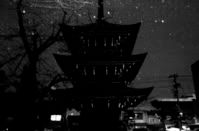Hotels: Now in Easy to Swallow Capsule Form
I’m a bit of a homebody. I like the outdoors and the countryside. Long lazy afternoons and quiet nights by the “fire” i.e.: kerosene heater. But, I can never go very long without a big city fix. Flashy signs advertising fantastic fashion and Jimmy Choo nock off stilettos on everybody’s feet clicking to the chirp of crosswalks. I love being lost in the crowds and perfectly anonymous with the rush of warm subway tunnel draft in my hair.
Recently Danny and I have pulled out all of our travel guides and gotten even more from the library. We are planning our big trip to Tokyo. Museums, galleries, Gothem city-like architecture and high end fashion window shopping. The Tokyo trip is a month away and like an addict I needed my city fix so this Saturday we headed down to Nagoya, the fourth largest city in Japan.
We rode the subway late at night to the entertainment areas and followed the bright lights. We wandered past bars, clubs restaurants, and pachinko parlors, and finally into the Host and Hostess club district where decorative men and women can be bought for conversation along with overpriced drinks. This activity is not to be confused with prostitution though in these areas the two are never far apart.
We made reservations at a capsule hotel, which was actually quite luxurious. For a fee you could get just about any type of facial, massage, or nail set. Plus there were restaurants, a lounge room, and pachinko. After checking in Danny and I were led through different colored doors not to see each other again until morning. I was given a bag with pajamas and towels as well as socks and a toothbrush (the underwear was in a vending machine). I put all of my clothes in a locker and after a dip in the hotel Onsen I was off to my capsule. It was about eight feet long and three and a half feet wide. It was equipped with a television, radio, alarm clock, headphones, mood lighting, flashlight, mirror, and of course bedding. My capsule was a top bunk and I couldn’t help but have these images flash through my head: a morgue, top bunk summer camp, and various scenes from The Matrix, Brazil, Fifth Element, and Bladerunner. I didn’t get a very good night’s sleep, but it was not the capsule. It probably had something to do with the Chinese food I ate for dinner that night.
was actually quite luxurious. For a fee you could get just about any type of facial, massage, or nail set. Plus there were restaurants, a lounge room, and pachinko. After checking in Danny and I were led through different colored doors not to see each other again until morning. I was given a bag with pajamas and towels as well as socks and a toothbrush (the underwear was in a vending machine). I put all of my clothes in a locker and after a dip in the hotel Onsen I was off to my capsule. It was about eight feet long and three and a half feet wide. It was equipped with a television, radio, alarm clock, headphones, mood lighting, flashlight, mirror, and of course bedding. My capsule was a top bunk and I couldn’t help but have these images flash through my head: a morgue, top bunk summer camp, and various scenes from The Matrix, Brazil, Fifth Element, and Bladerunner. I didn’t get a very good night’s sleep, but it was not the capsule. It probably had something to do with the Chinese food I ate for dinner that night.

The next day we spend most of our time in the city’s largest museum looking at a collection of the past 100 years of modern and went home happy and exhausted.
Toronto, London, Nagoya, and every other big city I have ever been to blend in my head and I can almost see them as the same place with their subways, airports, Starbucks, skyscrapers, and people. It may be the crazy intense fashion, the unique smells, the ultra modern multimedia signs that I can’t read or the language that I can’t understand but there is something unique and exciting about Japanese cities for me. I look forward to what Tokyo has to tell me next month.
Recently Danny and I have pulled out all of our travel guides and gotten even more from the library. We are planning our big trip to Tokyo. Museums, galleries, Gothem city-like architecture and high end fashion window shopping. The Tokyo trip is a month away and like an addict I needed my city fix so this Saturday we headed down to Nagoya, the fourth largest city in Japan.
We rode the subway late at night to the entertainment areas and followed the bright lights. We wandered past bars, clubs restaurants, and pachinko parlors, and finally into the Host and Hostess club district where decorative men and women can be bought for conversation along with overpriced drinks. This activity is not to be confused with prostitution though in these areas the two are never far apart.
We made reservations at a capsule hotel, which
The next day we spend most of our time in the city’s largest museum looking at a collection of the past 100 years of modern and went home happy and exhausted.
Toronto, London, Nagoya, and every other big city I have ever been to blend in my head and I can almost see them as the same place with their subways, airports, Starbucks, skyscrapers, and people. It may be the crazy intense fashion, the unique smells, the ultra modern multimedia signs that I can’t read or the language that I can’t understand but there is something unique and exciting about Japanese cities for me. I look forward to what Tokyo has to tell me next month.
